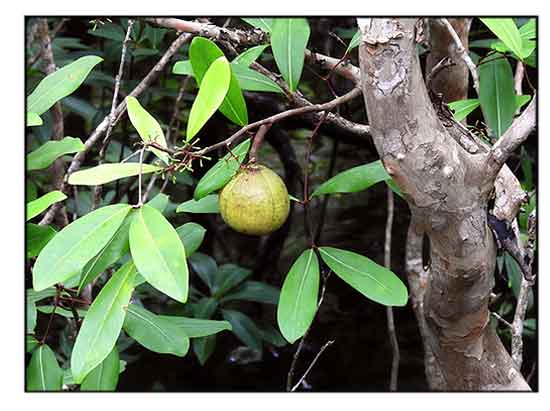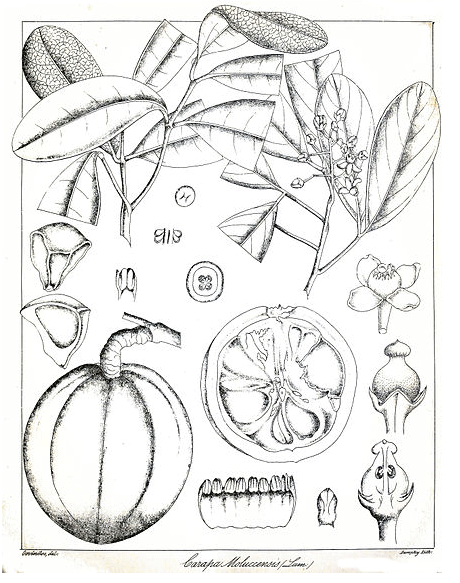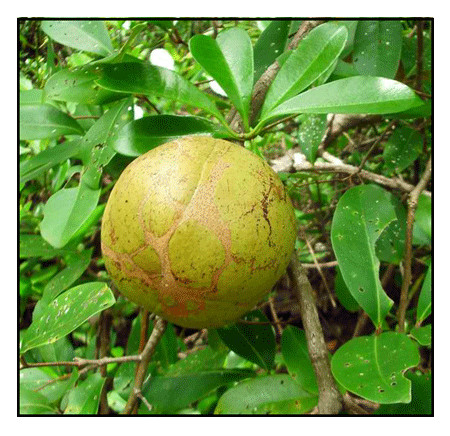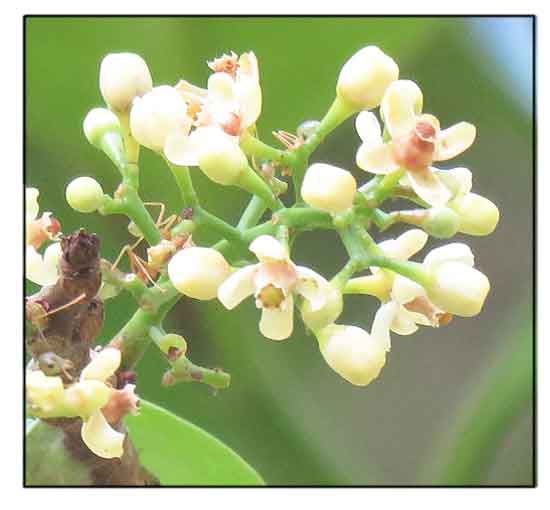 Gen info Gen info
- Xylocarpus is a genus of plants in the mahogany family Meliaceae. It contains 3 described species, all of which are mangroves viz., Xylocarpus moluccensis, X. granatum, and X. rumphii. (21)
- The genus was erected by botanist Johann Gerhard König to accommodate his newly described species X. granatum.
- Etymology: The genus name Xylocarpus is derived from Greek words xylon, meaning wood, and carpon, meaning fruit, referring to its large woody fruit, its size and shape of earning the common name "cannonball mangrove". (21) The species epithet moluccensis is named for the Moluccas archipelago (now Maluku Islands). (22)
Botany
• Xylocarpus moluccensis is a small to medium sized deciduous tree with a relative sparse canopy, growing to a height of 22 meters. Bole up to 100 centimeters in diameter. Bark is light brown, peeling in longitudinal flakes. Roots are pencil-like, stout pneumatophores (air-breathing). Leaves are compound, 20 centimeters long, with 2 to 6 pairs of opposite leaflets. Leaflets are elliptic to ovate, 4 to 12 centimeters long, 2 to 8 centimeters wide, with blunt or pointed tip. Inflorescense is 4 to 8 centimeters long with 9 to 35 flowers. Flowers are small and creamy white. Fruit is globular, woody, orange-sized (5 to 10 centimeters), containing 4 to 16 tightly packed, tetrahedral seeds which are 4 to 7 centimeters long. (1)
• X. moluccensis is similar to Xylocarpus granatum (piyagaw). X. granatum has larger fruit, smooth, patchy bark, butteresses and plant-like aerial roots. X. moluccensis has a smaller fruit, with conical pneumatophores. (1)
 • Growth form: Medium to large-sized tree, measuring up to 20 - 30 m tall, usually has a sparse canopy. Trunk: Trunk diameter measuring up to 70 - 200 cm, deeply fissured surface. Roots: Pointed, conical-shaped pneumatophores at the base of the trunk. Foliage: Leaves spirally arranged, usually 2 - 3 leaflets, each leaflet measuring 4 - 12 by 2 - 6.5 cm. Leaflets are paired, oval to heart or egg-shaped, leathery and with a broadly rounded to sharply tapered base. Leaflet stalk measure 1 - 3 mm long. Flowers: Occur in clusters located in the axils, flower clusters are 6 - 18.5 cm long and with a 2 - 10 mm long stalk. Calyx is flat, deeply 4-lobed, lobes measuring 1 - 1.7 mm long; calyx lobes are rounded, white and about 1.5 mm long. Flower consist of 4 petals, yellowish and oblong to egg-shaped, measuring 2 - 3 by 3.5 - 4 mm long; 8 stamens and a 2 - 2.5 mm long style. Fruit: Broadly ellipsoid greenish-brown fruit, measuring 8 - 11 cm in diameter, usually has 5 - 10 brown seeds measuring 4 - 6.5 cm long. (23) • Growth form: Medium to large-sized tree, measuring up to 20 - 30 m tall, usually has a sparse canopy. Trunk: Trunk diameter measuring up to 70 - 200 cm, deeply fissured surface. Roots: Pointed, conical-shaped pneumatophores at the base of the trunk. Foliage: Leaves spirally arranged, usually 2 - 3 leaflets, each leaflet measuring 4 - 12 by 2 - 6.5 cm. Leaflets are paired, oval to heart or egg-shaped, leathery and with a broadly rounded to sharply tapered base. Leaflet stalk measure 1 - 3 mm long. Flowers: Occur in clusters located in the axils, flower clusters are 6 - 18.5 cm long and with a 2 - 10 mm long stalk. Calyx is flat, deeply 4-lobed, lobes measuring 1 - 1.7 mm long; calyx lobes are rounded, white and about 1.5 mm long. Flower consist of 4 petals, yellowish and oblong to egg-shaped, measuring 2 - 3 by 3.5 - 4 mm long; 8 stamens and a 2 - 2.5 mm long style. Fruit: Broadly ellipsoid greenish-brown fruit, measuring 8 - 11 cm in diameter, usually has 5 - 10 brown seeds measuring 4 - 6.5 cm long. (23)
Distribution
- Native to the Philippines.
- Also native to Aldabra, Andaman Is., Bangladesh, Bismarck Archipelago, Borneo, Cambodia, Caroline Is., Comoros, Fiji, India, Jawa, Kenya, Laos, Lesser Sunda Is., Madagascar, Malaya, Maluku, Marianas, Mozambique, Myanmar, New Guinea, Nicobar Is., Queensland, Samoa, Seychelles, Solomon Is., Somalia, Sulawesi, Sumatera, Tanzania, Thailand, Tonga, Vanuatu, Vietnam. (8)
 Constituents Constituents
- Major phytoconstituents are alkaloids, steroids, tannins, proanthocyanidins, triterpenes, flavonoids, and limonoids. (4)
-
Bark yields flavonoids like catechin and epicatechin; limonoids like xyloccensin (A-I) and hispidol B. Bark is also rich in gedunin, xyloccensins L-V, 6-dehydroxyxylocarpin D. (4)
- Study of hexane extract of fruit seeds for active constituents yielded 4-hydroxybenzoic acid, arachidic acid, aromadedrin, coumaric acid, catechin, docosanediocic acid, behinic acid, febrifugin,
gedunin, hydroxymesicano lide, isolariciresinol, khayasin T, linoleic acid, linolenic acid, myristic acid, oleic acid, palmitic acid phaseic acid, phenyl acetic acid, photogedunin, procyanidin, stearic acid, swietemahonolide, xylogranatinin. Seed kernels yielded three new phragmalin limonoids, moluccensins H-J. (6)
- Study of bark yielded the presence of flavonoids (catechin and epicatechin), a few procyanidins (procyanidin B1, prcyanidin B3, procyanidin trimer, procyanidin pentamer, procyanidin hexamer, procyanidin decamer and procyaidinin undercamer). (7)
- A methanol root extract yielded two fractions. Fraction A yielded major component of α-guaiene (98.54%). Fraction B (oil) yielded 15 components. (see study below) (10)
- Study of seeds isolated two new mexicanolides, granatumins H and I and two phragmalins, granatumins J and K. (12)
- Study of seeds yielded two novel phragmalin 8,9,12-orthoesters, named thaixylomolins O–P (1–2), a 9,10-seco mexicanolide with a unique trans-orientation of H5 and Me-19, named thaixylomolin Q (3), and the first secomahoganin-type 7-nor-limonoid with a 6-oxabicyclo[3.2.1]octan-3-one motif, named thaixylomolin R (4). (see study below) (15)
 - Proximate analysis and mineral content study of X. moluccensis fruit seeds yielded
crude lipids (10.65-11.09%), crude proteins (4.76-10.14%). ash (10.07-11.59%), crude fibers (7.81-15.85%), and nitrogen free extract e.g. carbohydrates (52.42-63.32%). Mineral content yielded copper 12.82 ppm, iron 20.25 ppm, manganese 16.22 ppm, zinc 5.89 ppm, potassium 621.98 ppm, and calcium 43.69 ppm. Hexane extract yielded myristic acid, palmitic acid, stearic acid, oleic acid, linoleic acid, linolenic acid, arachidic acid, and docosanoic acid. (18) - Proximate analysis and mineral content study of X. moluccensis fruit seeds yielded
crude lipids (10.65-11.09%), crude proteins (4.76-10.14%). ash (10.07-11.59%), crude fibers (7.81-15.85%), and nitrogen free extract e.g. carbohydrates (52.42-63.32%). Mineral content yielded copper 12.82 ppm, iron 20.25 ppm, manganese 16.22 ppm, zinc 5.89 ppm, potassium 621.98 ppm, and calcium 43.69 ppm. Hexane extract yielded myristic acid, palmitic acid, stearic acid, oleic acid, linoleic acid, linolenic acid, arachidic acid, and docosanoic acid. (18)
- Study of ethyl acetate extract of stem bark isolated three compounds characterized as two tetrahydroxyterpenoids, namely xyloccensin E (1) and ruageanin D (2), and one flavonoid compound, 3,5,7,3'4'-pentahidroxyflavan (catechin) (3).
(see study below) (24)
- Study of seeds isolated 8 new khayanolides, thaixylomolins G-N (1-8), two new phragmalins (9,10), and two new mexicanolides (11,12). (see study below) (27)
- Crude extract of X. moluccensis yielded flavonoids +++. phenols ++. saponins ++. terpenoids +++, triterpenoids ++. tannins ++. resins/gums ++, with absence of alkaloids, steroids, glycosides, and cardiac glycosides. (see study below) (28)
Properties
- Studies have suggested antitumor, antibacterial, antihyperglycemic, antidyslipidemic, antidiarrheal, neuropharmacological, antioxidant, cardioprotective, α-glucosidase inhibitory, anticancer, antiviral, anxiolytic properties.
Parts used
Bark, fruit, ash, roots.
Uses
Edibility
- Fruit peels added to soups.
- Dried fruit peel used as appetizer. (3)
Folkloric
- In the Philippines, oil used to treat insect bites. (6)
-
Bark used for treatment of dysentery, diarrhea, and various abdominal troubles. (3)
- Also used as febrifuge. (3)
- Fruit and bark used in the treatment of fever, malaria, elephantiasis, swelling of the breast; as antiemetic, anti diarrheal. (4)
- An ointment made from seed ash of the plant mixed with sulphur and coconut oil used for treatment of itches. (5)
- In Fiji, leaves and bark used for carbuncles. In Bangladesh, bark used for gastrointestinal disturbances such as cholera, dysentery, diarrhea. In Malaya, bark used for cholera, colic diarrhea. (6)
Others
- Tannin: Bark rich in tannin. Used for tanning heavy hides, toughening fishing nets and dying cloth. (13)
- Wood. Used for making small objects i.e., pins, handles, house posts. Large pieces used for boat building and furniture making. (3)
- Biodiesel feedstock: Study suggest mangrove seeds of moluccensis have potential as biodiesel feedstock due to its lipid content. (18)
Studies
• Antibacterial: Various parts of X. moluccensis i.e., bark, pneumatophores, fruit husk, and leaves exhibited considerable antibacterial activity against a wide range of both Gram positive and Gram negative bacilli strains including E. coli, E. enterogenes, S. flexneri, S. sonnei, S. aureus, S. epidermis, S. pyogenes, V. cholera. (4)
• Antidiarrheal / Bark: A methanol extract of bark exhibited significant antidiarrheal activity in castor oil and magnesium sulphate induced diarrheal models in mice. (4)
• Neuropharmacological Properties / Bark and Pneumatophores: Study evaluated methanolic extracts of bark and pneumatophores of X. moluccensis for CNS effects in mice model. Results showed dose-dependent reduction of onset and duration of pentobarbitone-induced hypnosis, reduction of locomotor and exploratory activities in open field, hole cross, head-dip, and evasion tests. The pneumatophore extract showed more potency than the bark extract. (5)
• Cytotoxic / Antioxidant / Antibacterial / Fruit Husk: Study evaluated the toxicity, antioxidant, antibacterial activity of methanol extract of fruit husk of X. moluccensis. The extract showed no toxicity on brine shrimp lethality assay. The antiradical efficiency by DPPH assay was 0.000154. Antibacterial evaluation showed broad spectrum inhibitory zone to S. aureus and E. coli at 12.7 ± 1.2 and 11.9 ± 0.9 mm, respectively. (9)
• Cyclooxygenase, 5-Lipoxygenase and Acetylcholinesterase Inhibitory Effects / Roots: Study investigated the inhibitory effects of methanolic root extract and fractions (A & B) of X. moluccensis against cyclooxygenase, 5-lipoxygenase and acetylcholinesterase enzymes using in vitro models. Fraction A yielded α-guaiene (98.54%) as the major component. The α-guaiene fraction showed strong activities against AchE, 5-lipox, and COX-1 with IC50s of 21, 27, and 43 µg/mL, respectively. Results showed the potential therapeutic effects of the plant in the treatment of inflammatory related ailments and cognitive disorders. (10)
• Safety on Toxicity Study / Antidyslipidemic Activity / Patented Fraction: Study evaluated the essential safety pharmacology and toxicity profile of a new patented
(US 7959954 from CSIR-CDRI) bioactive fraction of mangrove X. moluccensis for antidyslipidemic activity. Study findings suggested the fraction is safe for use as a candidate drug for the treatment of dyslipidemia disorders. Clinical trials are suggested. (11)
•
Antihyperglycemic / Antidyslipidemic / Fruits: Study evaluated the antihyperglycemic and antidyslipidemic activity of EA fraction of fruits of X. granatum and X. moluccensis on animal models as well as in-vitro glucose uptake stimulatory effect and cytotoxicity effect in L6 skeletal muscle cells. Results showed both EA fractions were effective in improving glucose tolerance, decreasing blood glucose, serum cholesterol and triglyceride levels in STZ-induced rats and dyslipidemic hamsters, respectively. The fractions also increase glucose uptake by L6 skeletal muscle cells. (14)
• Limonoid / Thaixylomolin- P / Antitumor / Seeds: Study of seeds isolated thaixylomolin O-P (i,2), thaixylomolin Q (3), and thaixylomolin R (4). Thaixylomolin P exhibited antitumor activities against ovarian A2780 and A2780/T cells with an equal IC50 of 37.5 µM. (see study above) (15)
• Antidiarrheal / Antibacterial / Bark: Study evaluated the antidiarrheal activity of methanol extract of barks of Xylocarpus moluccensis in castor oil- and magnesium sulphate-induced diarrhea models in mice. Results showed significant antidiarrheal activity in both models. The ME showed antibacterial effect, with moderate inhibitory activity against E. coli, V. cholera, S. aureus, S. epidermis, S. dysentery, S. pyogenes, S. typhi, P. aeruginosa and E. aerogenes. Results suggest a potential for a novel 'lead' for antidiarrheal drug development. (16)
• Dyeing Viscose Rayon Fabric Using Environmental Friendly Mordant: Viscose rayon was dyed with natural colorant extracted from X. moluccensis heartwood using pressurized hot water extraction technique and an environmental friendly mordant of vinegar and paddy ash. (17)
• Limonoid / Anti-Inflammatory / Seeds: Study of seeds isolated a new andirobin, thaimoluccensin A (1), and two new phragmalin-type limonoids, thaimoluccensins B and C (2,3), along with eight known compounds. Compound 7, deacetylgedunin, a gedunin-type limonoid, exhibited significant inhibitory activity against nitric oxide production from activated macrophages with IC50 less than 10 µM, suggesting anti-inflammatory activity. (19)
• Cytotoxic / Anticancer Effects: Study investigated various extracts of 16 Bangladesh medicinal plants for cytotoxic activity against healthy mouse fibroblasts (NIH3T3) and three human cancer cell lines (gastric/AGS; colon/HT-29; and breast/MDA-MB-435S) using MTT assay. Seven methanolic extracts, including Xylocarpus moluccensis showed low toxicity (IC50 > 2.5 mg/mL) against mouse fibroblasts but selective cytotoxicity (IC50 0.2-2.3 mg/mL) against different cancer cell lines. (20)
• α-Glucosidase Inhibitory Activity / Antioxidant / Stem Bark: Study evaluated the antihyperglycemic potential of ethyl acetate extract of X. moluccensis stem bark and isolated compounds through
α-glucosidase inhibition and antioxidant effect. Study isolated three compounds characterized as two tetrahydroxyterpenoids, namely xyloccensin E (1) and ruageanin D (2), and one flavonoid compound, 3,5,7,3'4'-pentahidroxyflavan (catechin) (3). Compounds 1 and 3 inhibited the α-glucosidase enzyme with IC50s of 118.60 and 55.19 µg/ml, respectively, in a competitive inhibition mechanisms. Compounds 1 and 3 also showed antioxidant capacity via DPPH with IC50 of 54.69 and 2.87 µg/mL, and antioxidant capacity via FRAP with IC50s of 66.35 and 213.82 µmol Fe2+/g, respectively. (24)
• Protective against Cardiac Hypertrophy Via Angiogenesis and Regulation of NF-kB Inflammation / Fruits: Study evaluated the potential of ethyl acetate fraction from fruits of X. moluccensis alcoholic extract (CDR-267-F018) against cardiac hypertrophy in rats induced in Wistar rats through isoproterenol and treated with either propranolol or CDR-267-F018. Results showed CDR-267-F018 treatment reduced isoproterenol induced cardiac hypertrophy with reduction in ANP, BNP, ß-NHC, NPP-A and increased expression of vascular endothelial growth factor receptor 1. CDR-267-F018 treatment tightly regulated inflammation by controlling plasma pro-inflammatory cytokines TNFα and IFN-γ, plasma EMP level and NF-kB, Akt and ERK. CDR-267-F018 protected rat heart against isoproterenol induced cardiac hypertrophy by acting on inflammation, fibrosis, and by improving angiogenesis. (25)
• Cytotoxicity in Human Hepatocellular Carcinoma HepG2 Cell Line: Study evaluated the cytotoxic effects and mechanisms of cell death induced by crude and diethyl ether extract of X. moluccensis on human hepatocellular carcinoma cell line. Methanol extracts from X. moluccensis leaf exhibited cytoxicity effect with IC50 <30 µg/mL (72h). Diethyl ether extract of X. moluccensis leaf IC50 at 72 h was 0.22 µg/ml, more cytotoxic than crude methanol extract. Results suggest the extracts induced DNA fragmentation in the HepG2 cell line. The diethyl ether leaf extract triggered apoptotic cell death via activation of caspases -8, and -3/7. Results suggest potential as therapeutic agent for treatment of cancer. (26)
• Antiviral Limonoids / Seeds: Study of seeds isolated 8 new khayanolides, thaixylomolins G-N (1-8), two new phragmalins (9,10), and two new mexicanolides (11,12). The isolates were tested for antiviral activity against pandemic Influenza A virus (subtype H1N1) by assay of cytopathic inhibition effect. Three khayanolides, viz., thaixylomolins I, K, and M, exhibited moderate anti-H1N1 activities. The most potent, thaixylomodin I (IC50 of 77.1 µM) showed stronger inhibitory activity than positive control, ribavirin (IC50 185.9 µM). (27)
• Anxiolytic / Bark: Study evaluated the anxiolytic-like effects of methanolic bark extract of X. moluccensis (MEXM) in different behavioral paradigms (OFT-open field test, LDT-light dark test, SWT-swing test) in Swiss albino mice. Phytochemical analysis yielded flavonoids, phenols, saponins, terpenes and gums. MEXM caused significant anxiolytic-like effect. A dose of 500 mg/kg of MEXM and diazepam (2 mg/kg) significantly reduced the number of field crosses, rearings, and groomings in OFT. (28)
Availability
Wild-crafted. |

![]()







